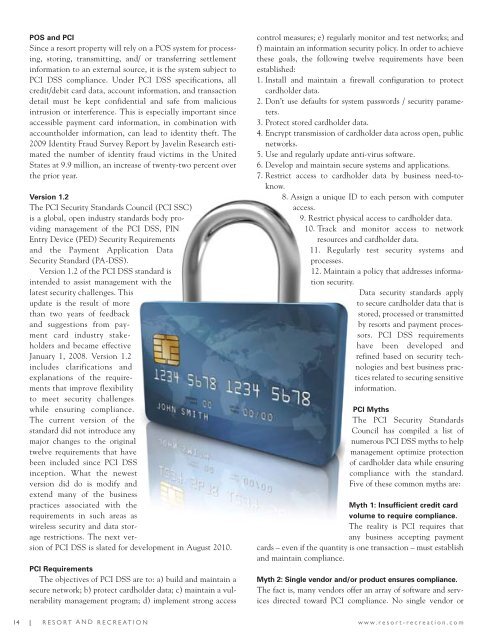Contents - Resort + Recreation Magazine
Contents - Resort + Recreation Magazine
Contents - Resort + Recreation Magazine
You also want an ePaper? Increase the reach of your titles
YUMPU automatically turns print PDFs into web optimized ePapers that Google loves.
POS and PCI<br />
Since a resort property will rely on a POS system for processing,<br />
storing, transmitting, and/ or transferring settlement<br />
information to an external source, it is the system subject to<br />
PCI DSS compliance. Under PCI DSS specifications, all<br />
credit/debit card data, account information, and transaction<br />
detail must be kept confidential and safe from malicious<br />
intrusion or interference. This is especially important since<br />
accessible payment card information, in combination with<br />
accountholder information, can lead to identity theft. The<br />
2009 Identity Fraud Survey Report by Javelin Research estimated<br />
the number of identity fraud victims in the United<br />
States at 9.9 million, an increase of twenty-two percent over<br />
the prior year.<br />
Version 1.2<br />
The PCI Security Standards Council (PCI SSC)<br />
is a global, open industry standards body providing<br />
management of the PCI DSS, PIN<br />
Entry Device (PED) Security Requirements<br />
and the Payment Application Data<br />
Security Standard (PA-DSS).<br />
Version 1.2 of the PCI DSS standard is<br />
intended to assist management with the<br />
latest security challenges. This<br />
update is the result of more<br />
than two years of feedback<br />
and suggestions from payment<br />
card industry stakeholders<br />
and became effective<br />
January 1, 2008. Version 1.2<br />
includes clarifications and<br />
explanations of the requirements<br />
that improve flexibility<br />
to meet security challenges<br />
while ensuring compliance.<br />
The current version of the<br />
standard did not introduce any<br />
major changes to the original<br />
twelve requirements that have<br />
been included since PCI DSS<br />
inception. What the newest<br />
version did do is modify and<br />
extend many of the business<br />
practices associated with the<br />
requirements in such areas as<br />
wireless security and data storage<br />
restrictions. The next version<br />
of PCI DSS is slated for development in August 2010.<br />
PCI Requirements<br />
The objectives of PCI DSS are to: a) build and maintain a<br />
secure network; b) protect cardholder data; c) maintain a vulnerability<br />
management program; d) implement strong access<br />
control measures; e) regularly monitor and test networks; and<br />
f) maintain an information security policy. In order to achieve<br />
these goals, the following twelve requirements have been<br />
established:<br />
1. Install and maintain a firewall configuration to protect<br />
cardholder data.<br />
2. Don’t use defaults for system passwords / security parameters.<br />
3. Protect stored cardholder data.<br />
4. Encrypt transmission of cardholder data across open, public<br />
networks.<br />
5. Use and regularly update anti-virus software.<br />
6. Develop and maintain secure systems and applications.<br />
7. Restrict access to cardholder data by business need-toknow.<br />
8. Assign a unique ID to each person with computer<br />
access.<br />
9. Restrict physical access to cardholder data.<br />
10. Track and monitor access to network<br />
resources and cardholder data.<br />
11. Regularly test security systems and<br />
processes.<br />
12. Maintain a policy that addresses information<br />
security.<br />
Data security standards apply<br />
to secure cardholder data that is<br />
stored, processed or transmitted<br />
by resorts and payment processors.<br />
PCI DSS requirements<br />
have been developed and<br />
refined based on security technologies<br />
and best business practices<br />
related to securing sensitive<br />
information.<br />
PCI Myths<br />
The PCI Security Standards<br />
Council has compiled a list of<br />
numerous PCI DSS myths to help<br />
management optimize protection<br />
of cardholder data while ensuring<br />
compliance with the standard.<br />
Five of these common myths are:<br />
Myth 1: Insufficient credit card<br />
volume to require compliance.<br />
The reality is PCI requires that<br />
any business accepting payment<br />
cards – even if the quantity is one transaction – must establish<br />
and maintain compliance.<br />
Myth 2: Single vendor and/or product ensures compliance.<br />
The fact is, many vendors offer an array of software and services<br />
directed toward PCI compliance. No single vendor or<br />
14 | RESORT AND RECREATION www.resort-recreation.com






